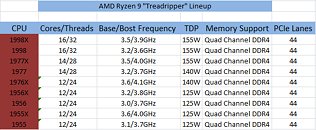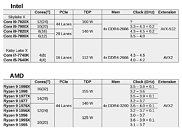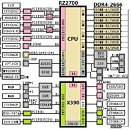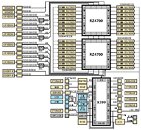Monday, May 15th 2017

AMD Ryzen 9 "Threadripper" Lineup Leaked
Today is an eventful day in the tech world, with two high-impact leaks already offering themselves up to our scrutiny. We had previously covered AMD's upcoming HEDT platform, based on the company's new X399 chipset, as having a quite distinctive lineup of processors, with not only 16 and 12-core offerings hot on foundries presses', but also some 14-core, 28-thread chips as well. Now, a leak has apparently revealed the entire Ryzen HEDT platform, whose processor marketing name, Ryzen 9, sounds really close to Intel's Core i9.
AMD's offerings look to offer an edge at least on core-count, with the Red team's top offerings, the Ryzen 9 1998X and Ryzen 9 1998, bringing in a game-changer 16 cores and 32 threads to the table. Perhaps even more importantly, we have to mention that the 1998X (these names, if true, are quite a mouthful, though) achieves a 3.5 GHz base, 3.9 GHz boost clock, which owes nothing to AMD's Ryzen 7 1800X consumer flagship CPUs. Rumors of AMD's frequency demise on higher core-count Ryzen CPUs have been greatly exaggerated, it would seem. And did I mention that these chips are coming with a TDP of 155 W - 5 W lower than Intel's purported 12-core, i9-7920X offering? Consider that for a moment.The 14-core parts are reported to be the Ryzen 9 1977X and Ryzen 9 1977. The Ryzen 9 1977X is a 155 W 14-core, 28-thread processor with a base clock speed of 3.5 GHz and a boost clock speed of 4.1 GHz with XFR. The Ryzen 9 1977 brings those speeds down a bit towards 3.2 GHz base and 3.7 GHz boost, with a correspondingly lower TDP of 140 W.
On to the 12-core parts, three different processors are expected: the Ryzen 9 1976X, Ryzen 9 1956X and the Ryzen 9 1956 (strange naming scheme with that 2-algharism difference between two parts with the same number of cores, I'd say.) The Ryzen 9 1976X is a 12-core, 24-thread, 140 W part, with a base clock 3.6 GHz and a boost clock speed of 4.1 GHz with XFR; the Ryzen 9 1956X lowers the TDP to just 125 W, on account of a lower base clock speed of 3.2 GHz and a boost clock speed of 3.8 GHz with XFR. The entry level 12 core part, the 1956, is rated at the same 125 W while running at a base clock speed of 3.0 GHz and a boost clock speed of 3.7 GHz.
There are also supposed to be two 10-core CPUs in this lineup, both rated at 125 W. The Ryzen 9 1955X, which runs at 3.6 GHZ base, and 4.0 GHz boost with XFR, and the Ryzen 9 1955, which runs at a base clock of 3.1 GHz and a 3.7 GHz boost.
I have to say, AMD is doing an amazing job with its Ryzen lineup, and the absolutely bonkers core-count on this X399, Whitehaven platform is most likely than not run circles around its Intel counterparts. Gone are the days of AMD's higher core count at the expense of computational power and IPC; as we've seen, AMD's Ryzen has achieved a great enough boost to its IPC that it can leverage its higher number, svelter cores over Intel's architecture, with absolutely mind-blowing TDP numbers (really, take another look at those TDPs in comparison to Intel's Core i9 series.)AMD's Whitehaven platform looks to be an attractive prospect. Let's just hope AMD's platform stability and compatibility quirks are fully ironed-out until the expected June release.
Source:
WCCFTech
AMD's offerings look to offer an edge at least on core-count, with the Red team's top offerings, the Ryzen 9 1998X and Ryzen 9 1998, bringing in a game-changer 16 cores and 32 threads to the table. Perhaps even more importantly, we have to mention that the 1998X (these names, if true, are quite a mouthful, though) achieves a 3.5 GHz base, 3.9 GHz boost clock, which owes nothing to AMD's Ryzen 7 1800X consumer flagship CPUs. Rumors of AMD's frequency demise on higher core-count Ryzen CPUs have been greatly exaggerated, it would seem. And did I mention that these chips are coming with a TDP of 155 W - 5 W lower than Intel's purported 12-core, i9-7920X offering? Consider that for a moment.The 14-core parts are reported to be the Ryzen 9 1977X and Ryzen 9 1977. The Ryzen 9 1977X is a 155 W 14-core, 28-thread processor with a base clock speed of 3.5 GHz and a boost clock speed of 4.1 GHz with XFR. The Ryzen 9 1977 brings those speeds down a bit towards 3.2 GHz base and 3.7 GHz boost, with a correspondingly lower TDP of 140 W.
On to the 12-core parts, three different processors are expected: the Ryzen 9 1976X, Ryzen 9 1956X and the Ryzen 9 1956 (strange naming scheme with that 2-algharism difference between two parts with the same number of cores, I'd say.) The Ryzen 9 1976X is a 12-core, 24-thread, 140 W part, with a base clock 3.6 GHz and a boost clock speed of 4.1 GHz with XFR; the Ryzen 9 1956X lowers the TDP to just 125 W, on account of a lower base clock speed of 3.2 GHz and a boost clock speed of 3.8 GHz with XFR. The entry level 12 core part, the 1956, is rated at the same 125 W while running at a base clock speed of 3.0 GHz and a boost clock speed of 3.7 GHz.
There are also supposed to be two 10-core CPUs in this lineup, both rated at 125 W. The Ryzen 9 1955X, which runs at 3.6 GHZ base, and 4.0 GHz boost with XFR, and the Ryzen 9 1955, which runs at a base clock of 3.1 GHz and a 3.7 GHz boost.
I have to say, AMD is doing an amazing job with its Ryzen lineup, and the absolutely bonkers core-count on this X399, Whitehaven platform is most likely than not run circles around its Intel counterparts. Gone are the days of AMD's higher core count at the expense of computational power and IPC; as we've seen, AMD's Ryzen has achieved a great enough boost to its IPC that it can leverage its higher number, svelter cores over Intel's architecture, with absolutely mind-blowing TDP numbers (really, take another look at those TDPs in comparison to Intel's Core i9 series.)AMD's Whitehaven platform looks to be an attractive prospect. Let's just hope AMD's platform stability and compatibility quirks are fully ironed-out until the expected June release.





83 Comments on AMD Ryzen 9 "Threadripper" Lineup Leaked
Also, Threadripper made me giggle like a 5-year old a little bit. :laugh:
That 155w for 16c 3.6ghz is pretty damn good considering what Intel has offered in that space.
Putting a 32 thread CPU in an ATX platform is cool in theory but not much else. IPC and power consumption are the only things that matter for HEDT/Consumer platforms, these chips are illogical and a waste of time for everyone involved.
Someone sure is mad they can't have one and don't have any work to do on it. Do you play rust and roof camp? You're pretty salty.
This is the future and it was always going to be this way, now its time for lazy devs to get there head out of there asses and get programming so we can make use of the power that is now infront of us.
I was going to upgrade to a AM4/+ system sometime next yr but this socket tome honestly looks more future proof and more exciting, so I might change my mind by then, time will tell.
To each its own, there are people who need 16 core CPU where as there are people who are currently fine with quad core.
What an amazing time to be an DIY enthusiast.
Right now I'm running an Asus R5E10 mobo and although it is very beautiful, the Haswell-E IMC architecture (circa August 2014), I do believe was NEVER designed to push DDR4 speeds of 3200MHz/14 latency, as my CPU package temps at idle approach 52C, when enabling the XMP 2.0 memory profile. 3200/14 DDR4 XMP on my Skylake 6700K rig, adds no significant heat at all, the CPU package temps idling at 28C, Go Figure. :D
The Skylake IMC is more advanced, than the Haswell-E, that's my takeaway from owning both platforms. And these AMD HEDT CPU memory specs are way up at 3200MHz, so that may sway my decision also to grab a 12-core "Threadripper". :)
I do SO LOVE my AMD RADEON PRO graphics card, it may not be a gamer, but it produces the most beautiful work screen and clarity of text I've ever laid eyes on. Two rigs is the way to go, work rig, gaming rig. :toast: